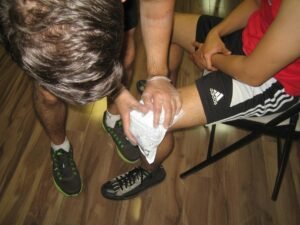The RICE method is comprised of rest, ice, compression and elevation. This approach is highly recommended for acute injuries. With the help of first aid care, it can help relieve pain, minimize the inflammation and provide protection to the damaged soft tissue.
Soft tissue injuries
Once an injury is sustained, the soft tissues that are damaged can swell, bruise or bleed and eventually become inflamed. The healing process takes place once the damaged tissues are replaced by collagen or scar tissue. In most cases, the tissue would require complete repair before an individual can resume any sports activity.
RICE method

- Rest – this is essential in order to protect the injured muscle, ligament, tendon or other tissues from further damage. In case of injuries, it is important that the individual will stop the activity and protect the injured part from further damage. Avoid bearing weight on the affected part and transfer to a safe area. By resting the injured part, it can promote better healing.
- Ice – when applying ice on the affected area, you should choose a cold pack or crushed ice that is wrapped in a towel. Performing ice massage is also an effective way to deliver cold to the damaged tissues. Always remember that cold can provide a short-term relief from pain as well as minimizing the swelling by reducing the flow of blood to the affected area. When applying ice on injuries always remember not to apply the ice directly on the skin and do not leave it for more than 20 minutes at a time. Prolonged exposure can result to damage to the skin and even frostbite. Always remember to apply cold compresses for 15 minutes and leave them long enough for the skin to re-warm itself.
- Compression – this helps minimize swelling that usually delays the healing process. A simple way to compress the affected area is to wrap a bandage around the swollen area. In case throbbing is felt or the wrap is too tight, remove the bandage and wrap loosely.
- Elevation – elevating the affected area can help control the swelling. This is effective once the injured part is raised higher that the heart level.
After 1-2 days of treatment, majority of strains, sprains and other injuries will start to heal. In case the pain or swelling does not minimize after 2 days, it is best to consult your doctor or go to the emergency room at the nearest hospital.
What to do once the healing process started
As soon as the healing process starts, light massage can help minimize the development of scar tissue as well as improve the healing of the tissues.
Take note that mild stretching can be initiated after the swelling has disappeared. It is best to work on the entire range of motion of the affected joint or muscle, but be careful not to force a stretch since it can result to injury again.
Heat can be used once the swelling and bleeding has been controlled. With the help of moist heat, it will boost the blood supply to the damaged part and promote the healing process.
